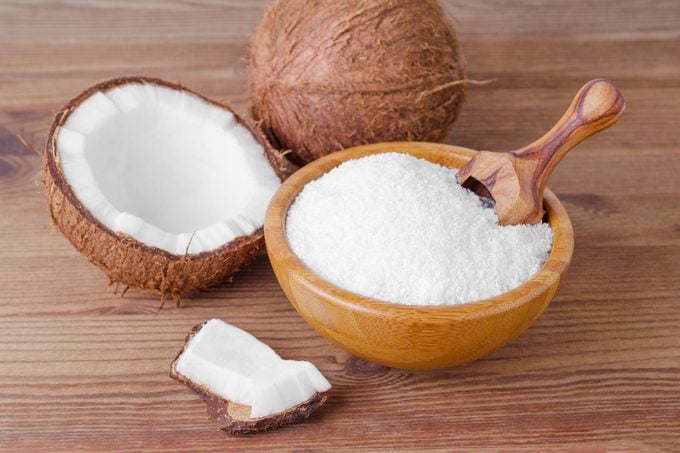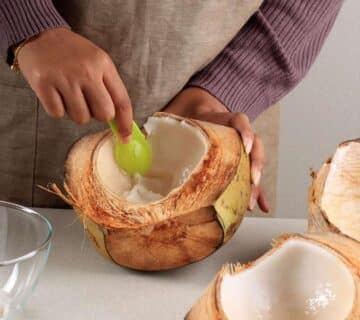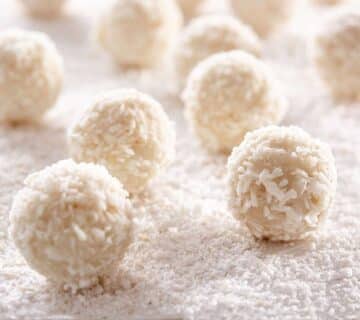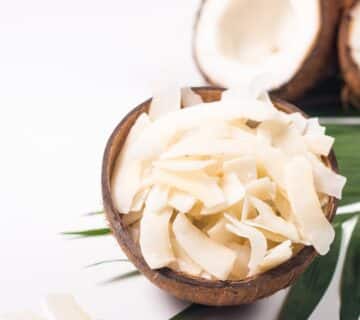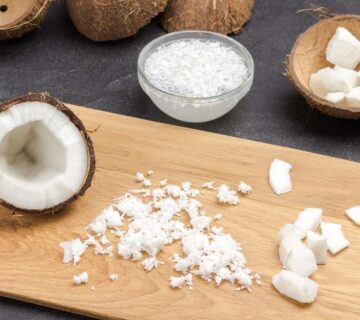Although they may look alike, coconut powder and coconut flour are actually not identical. Coconut flour is commonly utilized as a dairy-free alternative to milk when combined with water. In contrast, coconut flour is often substituted for wheat flour in gluten-free and keto-friendly baking recipes.
Therefore, it’s not advisable to replace coconut flour with coconut powder, as it would likely result in a failed recipe. But what other difference should you be aware of? Let’s explore the detailed differences between coconut powder and coconut flour.
The Difference Between Desiccated Coconut vs Coconut Flour
Desiccated coconut and coconut flour are two distinct coconut-derived products, each offering unique characteristics that cater to different culinary needs and dietary preferences. Here’s a detailed exploration of their differences:
1. Production Process
Desiccated coconut refers to coconut meat that has been shredded or flaked and then dried. The drying process typically involves heating the coconut meat to reduce its moisture content to around 2-3%.
This results in a dry, coarse texture while retaining the natural flavor and aroma of fresh coconut. But for your information, you can also make your own homemade desiccated coconut.
While coconut flour is made from the leftover coconut meat after coconut milk has been extracted. The meat is dried and then finely ground into a soft, flour-like powder. This process retains much of the coconut’s fiber content, which makes coconut flour high in dietary fiber.
2. Nutrition Profile
Desiccated coconut is rich in healthy saturated fats, particularly medium-chain triglycerides (MCTs), which are beneficial for energy and metabolism. It also contains dietary fiber, vitamins (such as manganese and copper), and minerals (like selenium and zinc). However, it is calorie-dense, with approximately 660 calories per 100 grams.
Coconut flour is significantly lower in calories compared to desiccated coconut, with about 400 calories per 100 grams. It is rich in dietary fiber, providing around 40 grams per 100 grams, which is beneficial for digestive health and satiety.
Coconut flour also contains moderate amounts of protein and is lower in fat compared to desiccated coconut.
3. Taste and Texture
Desiccated coconut has a pronounced coconut flavor with a slightly chewy texture due to its moisture content being reduced but not completely eliminated. It adds a crunchy texture and rich coconut taste to various dishes, making it popular in both sweet and savory recipes.
Coconut flour has a mild coconut flavor with a fine, powdery texture. It has high absorbency and tends to clump together, requiring more moisture when used in recipes. Baked goods made with coconut flour may have a denser texture due to its high fiber content.
4. How to Use It
Desiccated coconut finds widespread use in various culinary applications and food processing. Here are several ways to use it:
- Baking
Used in cakes, cookies, and bars to enhance flavor and texture.
- Cooking
Added to curries, salads, and savory dishes for a hint of coconut flavor and crunch.
- Toppings
Sprinkled over desserts, yogurt, or oatmeal for added texture and flavor.
- Snacks
Eaten as is or used in energy balls and granola bars for a nutritious snack.
While coconut flour is a versatile ingredient with a growing popularity in gluten-free and paleo diets. Here are how people usually use coconut flour:
- Baking
Used extensively in gluten-free and keto-friendly baking recipes such as muffins, pancakes, bread, and cookies.
- Thickening
Acts as a thickening agent in soups, stews, and sauces due to its high fiber content.
- Coating
Used to coat meat or fish before frying to create a crispy, gluten-free crust.
- Smoothies
Added to smoothies to boost fiber content and impart a subtle coconut flavor.
So, Desiccated Coconut or Coconut Flour?
Ultimately, the choice between desiccated coconut and coconut flour boils down to how you plan to use them in your cooking or baking. If you value texture, richness, and versatility in dishes, desiccated coconut is likely your go-to.
On the other hand, if you prioritize gluten-free options, high fiber content, and a finer texture in baking, coconut flour should be your pick. Both products offer distinct benefits, ensuring there’s a coconut-derived option to suit various dietary needs and culinary preferences.
For those looking to purchase desiccated coconut, especially in bulk for the food and beverage industry, consider Sari Coconut. As a certified supplier of coconut derivatives from Indonesia, Sari Coconut offers top-quality products and can also serve as a valuable partner for businesses seeking reliable coconut-based ingredients.
Beyond desiccated coconut, their range includes coconut oil, coconut charcoal briquettes, coconut sugar, coconut fiber, and more. For further information about our coconut products and partnership opportunities, reach out to Sari Coconut today and explore the diverse world of coconut derivatives.
FAQ
Can I substitute desiccated coconut for coconut flour in recipes?
Not directly. Desiccated coconut and coconut flour have different properties and uses. Desiccated coconut won’t provide the same fine texture or absorbency as coconut flour, and coconut flour requires more liquid and binding agents like eggs when used in baking.
Is coconut flour suitable for people with nut allergies?
Yes, coconut is classified as a fruit, not a nut. However, individuals with coconut allergies should avoid coconut products. Always check with a healthcare provider if you have severe allergies.
How should I store desiccated coconut and coconut flour?
Both should be stored in an airtight container in a cool, dry place. Coconut flour can be more prone to absorbing moisture, so refrigeration can extend its shelf life.
How do the environmental impacts of producing desiccated coconut and coconut flour compare?
Both products come from coconuts, a sustainable crop that requires fewer resources compared to other oil-producing plants. The production processes for both have relatively low environmental impacts, though the extensive use of coconuts for multiple products can raise concerns about biodiversity and land use in some regions.
Can I make desiccated coconut or coconut flour at home?
Yes, you can make both at home. For desiccated coconut, simply shred fresh coconut meat and dry it in an oven at a low temperature. For coconut flour, dehydrate the leftover pulp from making coconut milk and then grind it into a fine powder.

